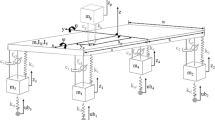Abstract
Advanced driver assistance systems (ADAS) has been introduced to address driver-related accidents. One of the advantages of ADASs is that they can provide autonomous control and tracking in overtaking manoeuvres via GPS through the designed trajectory. In this study, using adaptive sliding mode control, an integrated longitudinal and lateral control of 4-DOF vehicle’s nonlinear dynamic model, in presence of uncertainties, has been proposed. Adaptive control law is utilized for switching gain based on the variations in the sliding surface. Furthermore, a sliding mode control is designed in order to control the longitudinal slip of front wheels. Simulation results show proper tracking for dry roads and acceptable tracking in low adherence roads (wet roads) in overtaking manoeuvres.







Similar content being viewed by others
References
Urmson, C., Anhalt, J., Bagnell, D., et al.: Autonomous driving in urban environments: Boss and the urban challenge. Journal of Field Robotics. 25, 425–466 (2008)
Committee SO-RAVS. Taxonomy and definitions for terms related to on-road motor vehicle automated driving systems. SAE International 2014
AUTOMATED DRIVING SYSTEMS 2.0: A VISION FOR SAFETY - online: https://www.nhtsa.gov/sites/nhtsa.dot.gov/files/documents/13069a-ads2.0_090617_v9a_tag.pdf. NHTSA (National Highway Traffic Safety Administration) 2017
Wu, J., Liu, Y., Wang, F., et al.: Vehicle active steering control research based on two-DOF robust internal model control. Chinese Journal of Mechanical Engineering. 29, 739–746 (2016)
Poussot-Vassal, C., Sename, O., Dugard, L., et al.: Attitude and handling improvements through gain-scheduled suspensions and brakes control. Control. Eng. Pract. 19, 252–263 (2011)
Saikia A and Mahanta C. Vehicle stability enhancement using sliding mode based active front steering and direct yaw moment control. In: Control Conference (ICC), 2017 Indian 2017, pp.378-384. IEEE
Klier W, Reimann G and Reinelt W. Concept and functionality of the active front steering system. 2004. SAE Technical Paper
Li, H.-Z., Li, L., He, L., et al.: PID plus fuzzy logic method for torque control in traction control system. Int. J. Automot. Technol. 13, 441–450 (2012)
Li, L., Ran, X., Wu, K., et al.: A novel fuzzy logic correctional algorithm for traction control systems on uneven low-friction road conditions. Veh. Syst. Dyn. 53, 711–733 (2015)
Li, L., Jia, G., Chen, J., et al.: A novel vehicle dynamics stability control algorithm based on the hierarchical strategy with constrain of nonlinear tyre forces. Veh. Syst. Dyn. 53, 1093–1116 (2015)
Norouzi A, Masoumi M, Barari A, et al. Lateral control of an autonomous vehicle using integrated backstepping and sliding mode controller. 1464419318797051. DOI: https://doi.org/10.1177/1464419318797051
Borrelli, F., Falcone, P., Keviczky, T., et al.: MPC-based approach to active steering for autonomous vehicle systems. Int. J. Veh. Auton. Syst. 3, 265–291 (2005)
Bianchi, D., Borri, A., Di Benedetto, M.D., et al.: Adaptive integrated vehicle control using active front steering and rear torque vectoring. Int. J. Veh. Auton. Syst. 8, 85–105 (2010)
Hu, C., Jing, H., Wang, R., et al.: Robust H∞ output-feedback control for path following of autonomous ground vehicles. Mech. Syst. Signal Process. 70, 414–427 (2016)
Canale, M., Fagiano, L.: Stability control of 4WS vehicles using robust IMC techniques. Veh. Syst. Dyn. 46, 991–1011 (2008)
Norouzi, A., Kazemi, R., Azadi, S.: Vehicle lateral control in the presence of uncertainty for lane change maneuver using adaptive sliding mode control with fuzzy boundary layer. Proceedings of the Institution of Mechanical Engineers, Part I: Journal of Systems and Control Engineering. 232, 12–28 (2018)
Yoshida M, Nonaka K and Sekiguchi K. Model predictive vehicle control with side slip angle restriction with suppression of modeling error by sliding mode control. In: Control Applications (CCA), 2014 IEEE Conference on, pp.328-333. IEEE, 2014
Chen B-C, Tsai C-T and Lee K. Path-Following Steering Controller of Automated Lane Change System with Adaptive Preview Time. In: Systems, Man, and Cybernetics (SMC), 2015 IEEE International Conference on, pp.2522-2526. IEEE, 2015
You, F., Zhang, R., Lie, G., et al.: Trajectory planning and tracking control for autonomous lane change maneuver based on the cooperative vehicle infrastructure system. Expert Syst. Appl. 42, 5932–5946 (2015)
Rajamani, R.: Vehicle dynamics and control. Springer Science & Business Media (2011)
Ackermann, J: Robust control: Systems with uncertain physical parameters. Springer Science & Business Media, Berlin (2012)
Khalil, H.K.: Noninear systems, vol. 2, pp. 5–1. Prentice-Hall, Upper Saddle river (1996)
Singh, K.B., Arat, M.A., Taheri, S.: An intelligent tire based tire-road friction estimation technique and adaptive wheel slip controller for antilock brake system. J. Dyn. Syst. Meas. Control. 135, 031002 (2013)
Author information
Authors and Affiliations
Corresponding author
Additional information
Publisher’s Note
Springer Nature remains neutral with regard to jurisdictional claims in published maps and institutional affiliations.
Appendices
Appendix 1
Appendix 2
In order to prove the stability of the sliding mode control, the coefficient of switching surface can be obtained as follows [22]:
where,
And the upper and lower bounds of uncertainties for controller design are:
Appendix 3
In order to prove the stability of the proposed controller, the candidate Lyapunov function has been chosen as:
where,
In order to evaluate the Lyapunov function, the Lyapunov candidate function has been derived as:
According to Appendix 2,
Since ηy is a positive constant, the derivative of the Lyapunov function becomes negative only if γx is greater than 1, therefore:
Hence, by choosing γx greater than or equal to 1, we can guarantee the system’s stability based on the Lyapunov stability.
Appendix 4
In order to prove the stability of the proposed controller, the candidate Lyapunov function has been chosen as:
where,
In order to evaluate the Lyapunov function, the Lyapunov candidate function has been derived as:
According to Appendix 2,
Since ηy is a positive constant, the derivative of the Lyapunov function becomes negative only if γy is greater than 1, therefore:
Hence, by choosing γy greater than or equal to 1, we can guarantee the system’s stability based on the Lyapunov stability.
Rights and permissions
About this article
Cite this article
Norouzi, A., Barari, A. & Adibi-Asl, H. Stability Control of an Autonomous Vehicle in Overtaking Manoeuvre Using Wheel Slip Control. Int. J. ITS Res. 18, 320–330 (2020). https://doi.org/10.1007/s13177-019-00200-6
Received:
Revised:
Accepted:
Published:
Issue Date:
DOI: https://doi.org/10.1007/s13177-019-00200-6




